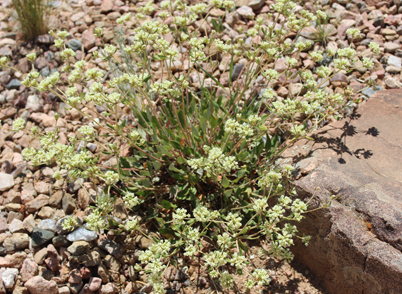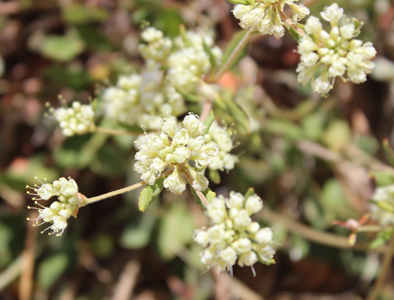 |
 |
The Plant w/flowers |
The Flowers |
Description
" Eriogonum jamesii is a species of wild buckwheat known by the common name James' buckwheat and antelope sage. It is native to the southwestern United States, being found in: Colorado, Utah, Arizona,Texas, New Mexico, Oklahoma, and Nebraska." (Wikipedia)
"Semi-desert, foothills, montane. Meadows, shrublands, woodlands. Summer, fall. Eriogonum jamesii and Eriogonum arcuatum can be difficult to tell apart, and, in fact, James Reveal, Eriogonum expert, indicates in his treatment of Eriogonum in the Flora of North America, "Eriogonum arcuatum has long been included under E. jamesii". In his key to Eriogonum (in the FNA and in the Flora of the Four Corners Region), Reveal gives them separate species status.
Stanley Welsh, Utah flora expert and one time Professor to Reveal, disagrees with Reveal and accepts just one species, E. jamesii: "The concept of E. jamesii is restricted [in FNA] to those [plants] with white to cream colored flowers. Use of flower color as the basis for segregation seems to this writer to be superfluous, and [therefore I maintain] the traditional application of the name E. jamesii".
The final volume of Intermountain Flora (2012 by Holmgren, Holmgren, and Reveal) indicates that in the Intermountain Region, there is just E. arcuatum. As the map below indicates, E. jamesii is almost exclusively found in Arizona, New Mexico, and Colorado.
E. jamesii and E. arcuatum are nearly identical in almost all of their characteristics and measurements; they are best separated, according to Reveal, by their flower color (yellow for E. arcuatumand white to cream for E. jamesii) and by their inflorescences (compound umbellate for E. jamesii and capitate of umbellate for E. arcuatum). In addition, although the upper side of the leaves of both species may be densely woolly-hairy, the upper side of E. jamesii leaves can be "thinly hairy or even glabrous".
Note that the E. jamesii plants shown on this page are growing in a warm, relatively moist environment and the E. arcuatum plantis growing in a hot, dry environment. Thus there is a considerable difference in their appearance. In similar environments, the two plants would look very similar.
The second photograph above shows the lovely pinks and reds that color the petals late in the flowering season.
Bentham named this species in 1856 from a specimen collected by Edwin James in the Rockies near the Platte in 1820. James was a highly respected long-time plant collector." (swcoloradowildflowers.com)
Ethnobotanical Uses
"The Navajo people have used Eriogonum jamesii as an oral contraceptive.[1] Among the Zuni people, the root is soaked in water and used as a wash for sore eyes. The fresh or dried root is also eaten for stomachaches.[2] The root is carried in the mouth for a sore tongue and then buried in a river bottom.[3] The ground blossom powder is given to ceremonial dancers impersonating anthropic gods to bring rain.[4]" (Wikipedia)
Internet Resources